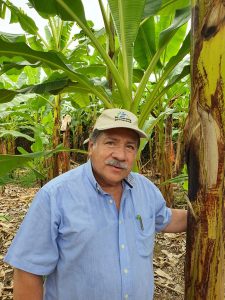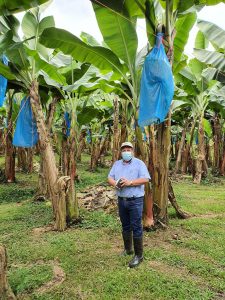Scroll down to read the interview in English.
¿Como se interesó en la investigación en banano y que camino educativo y profesional siguió?
 Nací en una familia feliz de escasos recursos económicos. Mi papa fue peón agrícola toda su vida en una finca cafetalera. En esta finca se encontraban sembradas también plantas de banano. Eran plantas del cv. Gros Michel, conocido en Costa Rica como banano criollo. Dichas plantas eran en realidad, el remanente de lo que en alguna ocasión fue una finca de banano.
Nací en una familia feliz de escasos recursos económicos. Mi papa fue peón agrícola toda su vida en una finca cafetalera. En esta finca se encontraban sembradas también plantas de banano. Eran plantas del cv. Gros Michel, conocido en Costa Rica como banano criollo. Dichas plantas eran en realidad, el remanente de lo que en alguna ocasión fue una finca de banano.
De niño tomábamos un racimo entre varios amigos y lo escondíamos tapándolo con las hojas y otros residuos de la planta. La alegría era volver una o dos semanas después y encontrar el racimo maduro. Después de comer algunos frutos, repartíamos el resto para llevarlo a las familias.
Una vez uno de mis abuelos me dijo: Ojalá un día pueda usted ir a la Universidad y entonces estudie esta planta, la cual nos da tanto alimento … y en verdad lo comíamos de diferentes maneras y formas. Años después, gracias a una beca otorgada por la Universidad de Costa Rica ingresé a estudiar agronomía. Para el requisito de graduación había que realizar una investigación con un cultivo. En mi caso hubo dos opciones: el banano y la caña de azúcar. Me acordé entonces de mi abuelo y escogí el banano y realicé mi tesis de Ingeniero agrónomo (Licenciatura en biotecnología) estableciendo la metodología para la micropropagación del banano en Costa Rica… Corría el año de 1984. Posteriormente, obtuve un trabajo en el Centro Agronómico Tropical de Investigación y Enseñanza (CATIE) y, en ese mismo lugar fui trabajador-estudiante gracias también a una beca facilitada por el CATIE y alcancé una maestría (MSc) en fitomejoramiento con énfasis en musáceas. Años después se presentó la oportunidad y opté por otra beca, esta vez de la Unión Europea y logré el sueño de estudiar un doctorado en Europa, en la Universidad de Ciencias y Técnicas de Montpellier con apoyo del CIRAD en Francia…Si se puede…
¿Cuánto tiempo trabajo en Corbana y cuál es el logro del que se siente más orgulloso durante su Carrera en Corbana?
Me llamaron para realizar un trabajo de consultoría por un período de tres meses en el laboratorio de Biotecnología. Se abrió una puerta y fui contratado oficialmente y, el 2 de octubre del 2021 cumplí 26 años de labores. Durante dicho lapso desempeñé trabajo como Profesional de Investigación, Coordinador de la Sección de Agrofisiología y, Subdirector y Director de Investigaciones.
Mi mayor satisfacción es el haber contribuido a apoyar y motivar a estudiantes universitarios para obtener sus grados académicos de bachiller y Licenciatura, mediante la realización de sus trabajos con investigaciones en banano y plátano y a colegas de CORBANA a capacitarse al más alto nivel obteniendo grados de maestría e inclusive de doctorado.
¿Qué consejo profesional le daría a los jóvenes investigadores que inician sus carreras?
Fijar una meta y trabajar responsablemente para alcanzarla. Actuar siempre con honestidad y disciplina. Mantener buenas relaciones humanas y trabajar en forma colaborativa. Los esfuerzos conjuntos dan mejores y más rápidos resultados. Los esfuerzos individuales ya no son la moda.
¿Que planea hacer durante su retiro?
Realizar más vida familiar. Visitar lugares que no conozco de mi país. Practicar el deporte de senderismo ecológico. Leer libros que tengo pendientes y como llevó la pasión de saber que está pasando con una reina de las frutas como lo es el banano, me gustaría estar actualizado durante unos 2 o 3 años más estableciendo relación con alguna Universidad, donde pueda optar por dictar el curso sobre cultivo del banano. Esto me permitiría el estar actualizado en tan importante cultivo, alimento esencial de millones de personas en el mundo.
¿Cuál es su cultivar de banano favorito y por qué?
Me gusta mucho el tipo criollo o Gros Michel. Esto debido a que era el banano que disponíamos durante mi niñez. Nos acostumbramos mucho a su aroma, sabor y grado de azúcar. Todavía se consigue en el mercado interno en Costa Rica. Claro está que también puedo degustar sin problema un banano Cavendish o un Pisang Mas.
Puede encontrar una lista de artículos de Jorge Sandoval en Musalit.
After 26 years devoted to banana research at CORBANA, Jorge Sandoval retires and encourages young researchers
 Jorge Sandoval, Director of Research at Corporación Bananera Nacional (CORBANA) in Costa Rica, and a MusaNet regional representative for MusaLAC (banana network for Latin America and the Caribbean). Here, he reflects on his career in a discussion with Rachel Chase from the Alliance of Bioversity International and CIAT.
Jorge Sandoval, Director of Research at Corporación Bananera Nacional (CORBANA) in Costa Rica, and a MusaNet regional representative for MusaLAC (banana network for Latin America and the Caribbean). Here, he reflects on his career in a discussion with Rachel Chase from the Alliance of Bioversity International and CIAT.
How did you first become interested in banana research and what educational and professional path did you take?
I was born in a happy family with limited financial resources. My father was an agricultural laborer all his life on a coffee farm. Banana plants were also planted on this farm. They were plants of cv. Gros Michel, known in Costa Rica as “criollo” banana. These plants were actually the remnants of what was once a banana farm. As a child we took banana bunches with several friends and hid them by covering them with leaves and other plant material. The joy was to return a week or two later and find the ripe bunches. After eating some fruits, we distributed the rest to local families. Once one of my grandparents told me: “I hope one day you can go to the University and then study this plant, which gives us so much food in different ways and forms”. Years later, thanks to a scholarship granted by the University of Costa Rica, I entered to study agronomy. For the graduation requirement, my research had to be done with a crop. In my case there were two options: banana and sugarcane. I remembered my grandfather and I chose bananas and did my thesis as an Agronomist (Bachelor’s of Biotechnology) in 1984, establishing the methodology for the micropropagation of bananas in Costa Rica. Later, I got a job at the Tropical Agronomic Center of Research and Teaching (CATIE) as a worker-student, and thanks to a scholarship facilitated by CATIE, I attained a Master’s degree (MSc) in plant breeding with an emphasis on Musaceae. Years later, another opportunity presented itself and I opted for another scholarship, this time from the European Union, where I achieved the dream of studying for a doctorate in Europe, at the University of Sciences and Techniques in Montpellier with support from CIRAD in France. “Yes we can!”
How long have you been at CORBANA and what is the accomplishment you are most proud of during your career there?
In 1995, CORBANA called me to do a consulting job for a period of three months in the Biotechnology laboratory. Then a door was opened and I was officially hired. On October 2, 2021, I completed 26 years of work at CORBANA. During this period, I worked as a field research investigator, Coordinator of the Agrophysiology Section, and Deputy Director and Director of Research. My greatest satisfaction is having contributed to supporting and motivating university students to obtain their Bachelor’s degrees by carrying out their work with research on banana and plantain. I also helped CORBANA colleagues train at the highest level, obtaining Master’s degrees and even Doctorate degrees.
What professional advice would you give young banana researchers who are starting their careers now?
Set a goal and work responsibly to achieve it. Always act with honesty and discipline. Maintain good human relationships and work collaboratively. Joint efforts give better and faster results. Individual efforts are no longer suitable.
What do you plan to do during your retirement?
Make more family life. Visit places that I don´t know in my country. Practice ecological hiking and read books that I have pending. Because I have the passion of knowing what is happening with bananas, the queen of fruits, I would like to be engaged for about 2 or 3 more years teaching about banana cultivation at a University. This would allow me to be updated in such an important crop, an essential food for millions of people in the world.
What is your favorite banana cultivar and why?
I really like the “Criollo” type or Gros Michel. This because it was the banana that we had during my childhood. We got very used to its aroma, flavor and degree of sugar. It´s still available in the domestic market in Costa Rica. Of course, I can also eat a Cavendish banana or another Pisang Mas without a problem.
You may find a list of articles by Jorge Sandoval in Musalit.
